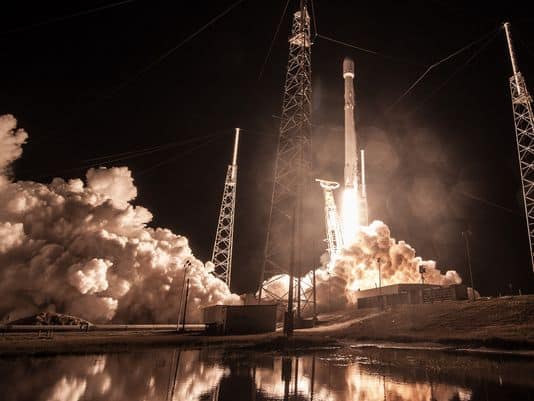
An enhanced iteration of SpaceX’s Falcon 9 rocket will make its debut at Kennedy Space Center on Monday when it launches Bangladesh’s first geostationary communications satellite, according to the latest Eastern Range launch schedule.
SpaceX will begin the long-awaited transition to “Block 5” versions of Falcon 9, which feature upgraded reusability and efficiency, with the launch from KSC’s pad 39A during a roughly two-hour window that opens at 4 p.m. The booster will target a landing on the company’s Of Course I Still Love You drone ship shortly after liftoff, then return to Port Canaveral before the end of next week.
Monday’s mission marks the first time SpaceX will use 39A since the much-vaunted Falcon Heavy rocket ensorcelled crowds across the world during its debut flight with a Tesla Roadster and “Starman” on Feb. 6.
Block 5, which marks the final version of Falcon 9, incorporates lessons learned from more than two years of launching, landing and re-launching rockets.
“We’re trying to summarize all of these lessons learned into a booster that then is able to fly and be recovered and fly again multiple times without a lot of refurbishment,” Hans Koenigsmann, SpaceX’s vice president of build and flight reliability, told FLORIDA TODAY in April. “It’s a reliability upgrade that combines reliability and reusability.”
Block 4 versions of Falcon 9 can fly twice, but the new Block 5 model could fly 10 or more times, CEO Elon Musk said last year. Part of that jump in potential reuse is due to an improved heatshield at the base of the rocket.
The nearly 8,000-pound Bangabandhu-1 satellite, operated by the Bangladesh Communication Satellite Company, should deliver commercial communications capabilities to a swath of Asia for up to 15 years after being placed into orbit. The country will become the 58th in history to operate its own geostationary satellite.
But first, United Launch Alliance teams in California are targeting early Saturday for the West Coast’s first-ever interplanetary launch. An Atlas V rocket will boost NASA’s newest Mars lander, named InSight, during a two-hour window that opens at 4:05 a.m. Pacific time.
InSight will study the interior of Mars by measuring its seismology and temperature in an effort to help scientists understand the early evolutions of rocky planets, including Earth.
Also on Saturday, a SpaceX Dragon spacecraft that launched from Cape Canaveral in April will depart the International Space Station with return cargo and science experiments for an eventual splashdown in the Pacific Ocean off the coast of Baja, California. NASA will stream the 9:24 a.m. ET departure at nasa.gov/multimedia/nasatv/.
Have you tried 321 LAUNCH?
Thanks to cutting-edge augmented reality technology, or the overlaying of digital objects onto the real world made possible by mobile cameras, spaceflight now fits in your pocket. Explore launch pads, rockets and live launches in detail right on your smartphone.
Find the free 321 LAUNCH app in Apple’s App Store or in Google Play for Android devices.
Version 1.1 of the app now supports United Launch Alliance’s Atlas V rocket in all of its configurations. If you already have the app, be sure to update it to the latest version.
System requirements list:
Apple: iPhone 6S or newer; fifth-generation iPad (2017) or newer. All require iOS 11 and later.
Android’s AR capabilities are limited to specific models running 7.0 Nougat and later. See the full list at developers.google.com/ar/discover/























